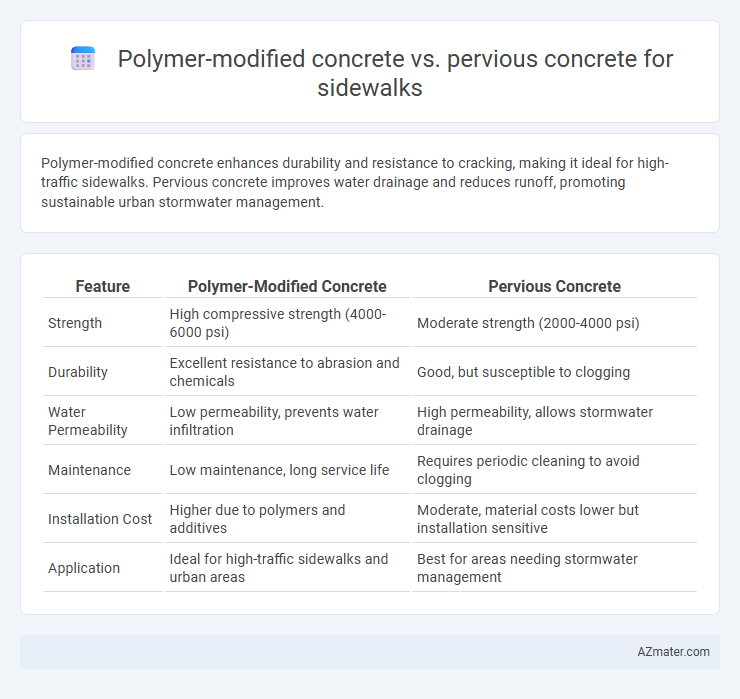Polymer-modified concrete enhances durability and resistance to cracking, making it ideal for high-traffic sidewalks. Pervious concrete improves water drainage and reduces runoff, promoting sustainable urban stormwater management.
Table of Comparison
| Feature | Polymer-Modified Concrete | Pervious Concrete |
|---|---|---|
| Strength | High compressive strength (4000-6000 psi) | Moderate strength (2000-4000 psi) |
| Durability | Excellent resistance to abrasion and chemicals | Good, but susceptible to clogging |
| Water Permeability | Low permeability, prevents water infiltration | High permeability, allows stormwater drainage |
| Maintenance | Low maintenance, long service life | Requires periodic cleaning to avoid clogging |
| Installation Cost | Higher due to polymers and additives | Moderate, material costs lower but installation sensitive |
| Application | Ideal for high-traffic sidewalks and urban areas | Best for areas needing stormwater management |
Introduction to Sidewalk Materials
Polymer-modified concrete enhances traditional concrete by incorporating polymers that improve adhesion, flexibility, and durability, making it highly resistant to cracking and weathering in sidewalk applications. Pervious concrete, designed with high porosity, allows water to pass through, reducing surface runoff and promoting groundwater recharge, which is ideal for sustainable urban design. Selecting between polymer-modified and pervious concrete depends on factors such as load-bearing requirements, environmental goals, and maintenance considerations for sidewalks.
Overview of Polymer-Modified Concrete
Polymer-modified concrete incorporates synthetic polymers to enhance durability, flexibility, and adhesion, making it ideal for sidewalks exposed to heavy traffic and harsh weather conditions. This type of concrete offers improved resistance to cracking, abrasion, and chemical attacks, extending the lifespan of pedestrian pathways. Compared to pervious concrete, polymer-modified concrete provides a denser surface, reducing water permeability while maintaining strength and structural integrity.
Overview of Pervious Concrete
Pervious concrete is a highly porous material designed to allow water to infiltrate through the pavement surface, significantly reducing stormwater runoff and improving groundwater recharge. It consists of a mixture of cement, coarse aggregates, and little to no fine aggregates, creating interconnected void spaces that manage surface water efficiently. Widely used for sidewalks in urban areas, pervious concrete enhances sustainability by mitigating flooding, reducing heat island effects, and improving environmental quality compared to traditional polymer-modified concrete.
Performance Comparison: Durability and Strength
Polymer-modified concrete exhibits superior durability and enhanced compressive strength compared to pervious concrete, making it more resistant to cracking and environmental wear on sidewalks. Pervious concrete allows better water drainage, which reduces hydrostatic pressure but typically has lower compressive strength and is more susceptible to freeze-thaw damage. For sidewalks requiring long-term structural integrity under heavy loads, polymer-modified concrete outperforms pervious concrete by providing enhanced toughness and resilience against weathering.
Water Permeability and Drainage Capabilities
Polymer-modified concrete offers enhanced water permeability compared to traditional concrete by incorporating polymers that reduce porosity and improve durability, yet it typically exhibits lower drainage capabilities than pervious concrete. Pervious concrete is designed with interconnected voids, enabling high water permeability and superior drainage, which effectively reduces surface runoff and promotes groundwater recharge. For sidewalks requiring efficient stormwater management, pervious concrete provides optimal water permeability and drainage performance, while polymer-modified concrete delivers increased strength but limited permeability.
Installation Process and Workability
Polymer-modified concrete offers enhanced adhesion and flexibility, allowing for easier shaping and finishing during sidewalk installation compared to traditional mixes. Pervious concrete requires careful handling to maintain its porous structure, necessitating specialized finishing techniques such as controlled vibration and surface tamping to ensure permeability while preventing clogging. Polymer-modified concrete typically provides improved workability and faster curing times, reducing installation duration and enhancing durability in pedestrian traffic areas.
Maintenance Requirements and Lifespan
Polymer-modified concrete offers enhanced durability and reduced maintenance requirements compared to traditional mixes, making it ideal for high-traffic sidewalks due to its resistance to cracking and chemical damage. Pervious concrete, designed for improved water drainage, requires frequent vacuuming and cleaning to prevent clogging and maintain permeability, which can increase maintenance efforts over time. Lifespan for polymer-modified concrete typically exceeds 30 years with minimal upkeep, whereas pervious concrete may have a shorter lifespan of 15 to 20 years unless regularly maintained.
Environmental Impact and Sustainability
Polymer-modified concrete enhances durability and reduces maintenance frequency, minimizing resource consumption over the sidewalk's lifecycle. Pervious concrete improves stormwater management by allowing water infiltration, reducing runoff and promoting groundwater recharge, which benefits urban ecosystems. Both materials contribute to sustainability, with pervious concrete offering superior environmental benefits in managing water quality and mitigating heat island effects.
Cost Analysis: Initial and Long-Term Expense
Polymer-modified concrete typically incurs higher initial costs due to the addition of synthetic resins but offers enhanced durability and reduced maintenance expenses over time, making it economically favorable for long-term sidewalk applications. Pervious concrete has a lower upfront cost and provides excellent stormwater management benefits, yet it often requires more frequent repairs and maintenance, increasing overall lifecycle expenses. Evaluating initial installation budgets alongside anticipated maintenance costs is crucial for determining the most cost-effective sidewalk material between polymer-modified and pervious concrete.
Best Applications: Choosing the Optimal Concrete for Sidewalks
Polymer-modified concrete provides enhanced durability, chemical resistance, and flexibility, making it ideal for sidewalks in high-traffic urban areas prone to heavy loads and environmental stress. Pervious concrete is best suited for sidewalks in regions requiring efficient stormwater management, allowing water infiltration to reduce runoff and prevent flooding. Selecting the optimal concrete depends on balancing durability needs with permeability requirements, ensuring long-term performance and environmental benefits specific to sidewalk applications.

Infographic: Polymer-modified concrete vs Pervious concrete for Sidewalk
 azmater.com
azmater.com